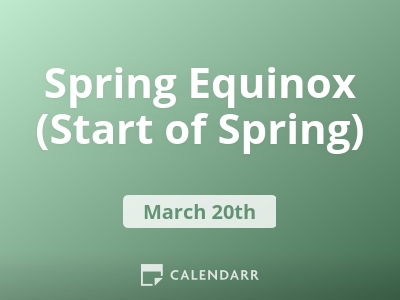- Calendar
- Calendar 2026
- March
- Spring Equinox (Start of Spring)
Spring Equinox (Start of Spring)
The Spring Equinox, also known as Vernal Equinox and March Equinox, happens every year usually on March 20 (some years it can take place on March 19 or 21), and it is the day that marks the beginning of Spring.
This Equinox is used to measure the length of a tropical year, or how long the Earth takes to do one orbit around the Sun. The average length is 365 days, 5 hours and 48 minutes.
Learn more about the First Day of Spring.
What is the Spring Equinox?
The Spring Equinox happens on the specific moment in time when the Sun is directly above the Earth’s equator, which happens when the Sun is crossing the celestial equator, an imaginary line above the equator, from South to North. This occurs at the same time everywhere in the World, however, the date and time of the Equinox vary from country to country due to the year that it happens in and the time zones.
This happens only twice in one year, and these are the only times when the Sun rises due East and sets due West, for everyone in the World.
Usually, the Earth has a tilt of 23.4°, however, during the Equinox, the Earth’s tilt is zero in relation to the sun, meaning it is not pointing towards or away from it, but rather the tilt is perpendicular to the sun’s rays. After the Spring Equinox, it is the Northern Hemisphere that is pointing towards the sun, which is why the days become longer and warmer.
The Meaning of Equinox
The word Equinox derives from the Latin aequus (equal) and nox (night), so the definition of it is Equal Night, which is so because on the day of the Spring Equinox, day and night last for approximately the same length of time (about 12 hours).
This is the same for all parts of the World, and it means that with the arrival of the first day of Spring we have earlier dawns and later sunsets.
Spring Equinox Celebrations
Since ancient times, people celebrate the arrival of Spring with pagan rituals and traditions, as a commemoration of new beginnings and the renewal of nature.
Chichen Itza, Mexico
The Mayan people were very connected to the sun, regularly observing its path to track the sunrises and sunsets and measure the length of the days to create their calendars.
During the Spring Equinox, the Mayans would perform sacrificial rituals on the famous El Castillo Pyramid. Built in 1000 A.D, the sunlight hits one of the four sides of the pyramid, signalling the arrival of a new season. At the beginning of Spring, the sun hits the pyramid in a way that makes it look like a huge snake is sliding down the stairs, which the Mayans called “the return of the Sun Serpent”.
Cahokia Woodhenge
The Cahokia Woodhenge near Illinois was built between 900 and 1100 C.E and consisted of big timber circles located to the West of Monks Moundat. It was thought to be a solar calendar to mark the equinoxes and solstices, as well as sunrises and sunsets.
The Holiday of Ostara
Ostara is a German Goddess who is the namesake of Easter in some languages. On March 21, the Wiccan celebrate a holiday named after the Goddess, as she is associated with the arrival of spring and rebirth, which is why her festival is celebrated on the Spring Equinox.

Other Celebrations
-
Feb 02 Sun
-
Mar 20 Thu
-
Apr 20 Sun
-
Jun 20 Fri
-
Sep 22 Mon
-
Nov 02 Sun

Spring Equinox (Start of Spring) - Next years
Saturday, 20 March 2027
Monday, 20 March 2028
Tuesday, 20 March 2029











